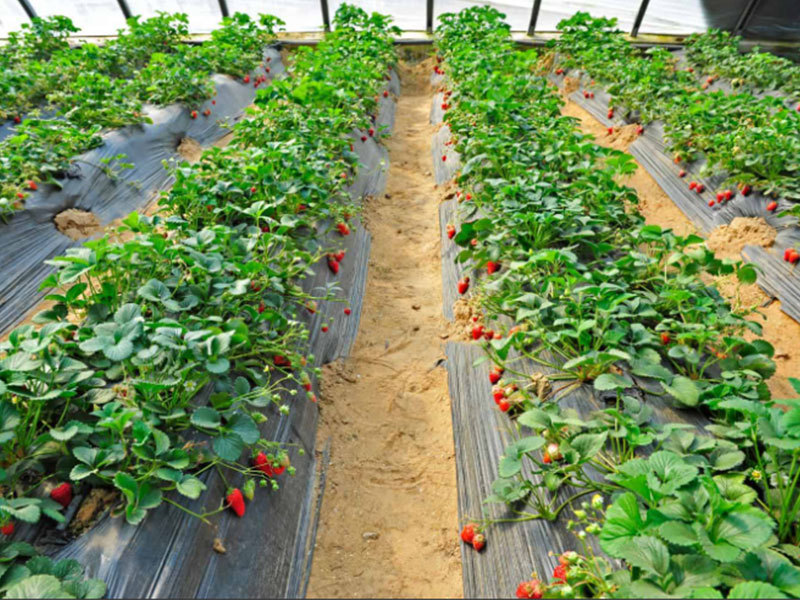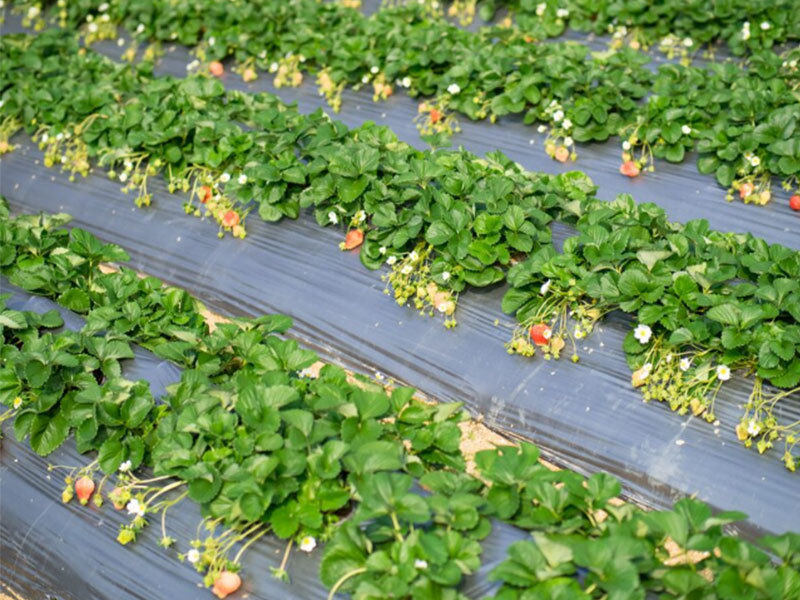how to plant strawberry by agricultural plastic film ?
Publish Time:
2025-07-23
Planting strawberries using agricultural plastic film (also known as mulch film) is a popular technique that offers multiple benefits, including weed control, moisture retention, soil temperature regulation, and reduced fruit rot by keeping berries off the soil. Below is a step-by-step guide to help you successfully plant strawberries with plastic film:
Planting strawberries using agricultural plastic film (also known as mulch film) is a popular technique that offers multiple benefits, including weed control, moisture retention, soil temperature regulation, and reduced fruit rot by keeping berries off the soil. Below is a step-by-step guide to help you successfully plant strawberries with plastic film:
1. Prepare the Soil
Choose the right location: Strawberries thrive in well-drained, fertile soil with full sun (6–8 hours of sunlight daily). Avoid low-lying areas prone to waterlogging.
Soil testing and amendment:
Test the soil pH; strawberries prefer slightly acidic soil (pH 5.5–6.5). Adjust with lime (to raise pH) or sulfur (to lower pH) if needed.
Add organic matter like compost, well-rotted manure, or peat moss to improve soil structure and fertility. Till the soil to a depth of 8–10 inches (20–25 cm) to mix amendments evenly.
Remove weeds and debris: Clear the area of rocks, roots, and existing weeds to prevent competition later.
2. Select the Plastic Film
Type of plastic film:
Black plastic film: Most common; blocks sunlight to suppress weeds and warms the soil (ideal for cooler climates).
Clear plastic film: Warms the soil more effectively but may allow weeds to grow (use with herbicides if needed).
Perforated or biodegradable film: Perforated films allow water penetration; biodegradable options reduce plastic waste (suitable for short growing seasons).
Width and thickness: Choose film width based on your bed size (typically 3–4 feet/0.9–1.2 m wide). Thickness of 1.5–2 mil (0.04–0.05 mm) works well for annual use.
3. Prepare the Planting Beds
Shape the beds: Create raised beds (6–8 inches/15–20 cm high) to improve drainage. Beds should be 3–4 feet (0.9–1.2 m) wide, with 1–2 feet (0.3–0.6 m) of space between beds for walking.
Smooth the soil surface: Rake the bed to remove clumps and create a flat, even surface. This ensures the plastic film lies tightly against the soil.
4. Lay the Plastic Film
Timing: Lay the film 1–2 weeks before planting to warm the soil (critical in cooler regions).
Securing the film:
Unroll the plastic film over the bed, ensuring it covers the entire surface with a slight overlap (6–12 inches/15–30 cm) on all sides.
Bury the edges of the film 4–6 inches (10–15 cm) deep in the soil along the bed’s perimeter to anchor it. Use soil, rocks, or landscape staples (every 1–2 feet/0.3–0.6 m) to prevent wind from lifting the film.
For extra security, create a tight seal by pressing soil firmly over the edges.
5. Plant the Strawberries
Choose healthy plants: Select disease-free, bare-root or potted strawberry seedlings. June-bearing varieties (produce one crop in summer) or everbearing/day-neutral varieties (produce multiple crops) work well.
Mark planting holes:
Space plants 12–18 inches (30–45 cm) apart in rows, with 2–3 feet (0.6–0.9 m) between rows (if using multiple rows per bed).
Use a marker to outline where each plant will go on the plastic film.
Cut holes for planting:
Use a sharp knife or scissors to cut X-shaped slits (3–4 inches/7–10 cm wide) at each marked spot. Alternatively, cut circular holes.
Planting technique:
Gently remove seedlings from pots or soak bare roots in water for 30 minutes.
Pull back the plastic flaps created by the X-slit and dig a small hole in the soil.
Place the plant in the hole, ensuring the crown (where roots meet stems) is level with the soil surface (burying the crown causes rot; leaving roots exposed dries them out).
Firm the soil around the roots and close the plastic flaps around the stem to secure the plant and reduce weed growth.
6. Post-Planting Care
Watering:
After planting, water thoroughly to settle the soil. Use drip irrigation beneath the plastic film to deliver water directly to roots (avoids wetting leaves and reduces disease risk).
Strawberries need consistent moisture (1–1.5 inches/2.5–3.8 cm of water weekly). Check soil moisture regularly; the plastic film retains moisture, but avoid overwatering.
Fertilization:
Apply a balanced fertilizer (e.g., 10-10-10) at planting time, following package instructions.
Side-dress with nitrogen-rich fertilizer (e.g., 21-0-0) 4–6 weeks after planting to promote leaf growth.
Pollination: Strawberries are self-pollinating, but bees improve fruit size and shape. Avoid using insecticides that harm pollinators.
Runners management: Pinch off runners (long stems with baby plants) in the first year to focus energy on fruit production. In subsequent years, allow some runners to root for new plants.
7. Harvesting and Maintenance
Harvest timing: Pick strawberries when fully red (color develops from the tip to the stem). Harvest in the morning when berries are cool.
Remove old foliage: After harvest, cut back old leaves to 1 inch (2.5 cm) above the crown to encourage new growth.
Replacing plastic film: Black plastic film can be reused for 1–2 seasons, but replace it if it tears or weeds breakthrough. Biodegradable film will break down naturally.
Benefits of Using Plastic Film for Strawberries
Weed control: Eliminates the need for frequent weeding.
Moisture conservation: Reduces evaporation, lowering water usage.
Soil warming: Accelerates growth and fruiting in cooler climates.
Cleaner fruit: Prevents berries from touching wet soil, reducing rot and disease.
By following these steps, you can maximize your strawberry yield and simplify maintenance using agricultural plastic film!
|
|
|
Previous
BLOGS

Unveiling the Power of Black&Silver Color Plastic Mulch Films in Agriculture
Discover how Black&Silver Color Plastic Mulch Films can revolutionize your farming strategy. Learn about their benefits and applications.

Unlocking the Benefits of Black Embossed Mulch Film in Modern Agriculture
Explore the latest trends and advantages of using black embossed mulch film in agriculture.

Unlocking the Secrets of Black&Silver Color Plastic Mulch Films
Discover the benefits and applications of Black&Silver Color Plastic Mulch Films in gardening and agriculture.

Unlocking the Secrets of Black Embossed Mulch Film in Modern Agriculture
Discover how Black Embossed Mulch Film is revolutionizing farming practices and enhancing crop yields.

Mastering Strawberry Planting Skills for a Bountiful Harvest
Unlock the secrets of effective strawberry planting skills and enjoy a thriving garden full of juicy strawberries!

The Wonders of Black Embossed Mulch Film: A Gardener's Best Friend
Discover how black embossed mulch film can revolutionize your gardening experience. Learn tips and benefits!









